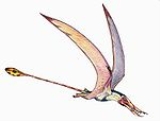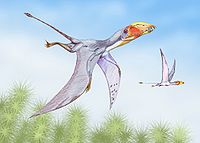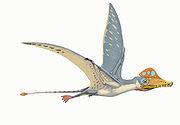
Rhamphorhynchoidea
Encyclopedia
The Rhamphorhynchoidea forms one of the two suborders of pterosaur
s and represent an evolutionary grade
of primitive members of this group of flying reptile
s. This suborder is paraphyletic in relation to the Pterodactyloidea
, which arose from within the Rhamphorhynchoidea, not from a more distant common ancestor. Because it is not a completely natural grouping, Rhamphorhynchoidea is not used as a formal group in most scientific literature, though some pterosaur scientists continue to use it as an informal grouping in popular works, such as The Pterosaurs: From Deep Time by David Unwin, and in some formal studies. Ramphorhynchoids were the first pterosaurs to have appeared, in the late Triassic
Period. Unlike their descendants the pterodactyloids, most rhamphorhynchoids had teeth and long tails, and most species lacked a bony crest, though several are known to have crests formed from soft tissue like keratin
. They were generally small. Nearly all had become extinct by the end of the Jurassic
Period, though least one anurognathid genus, Dendrorhynchoides
, persisted to the early Cretaceous. In addition the family Wukongopteridae
, which shows a mix of rhamphorynchoid and pterodactyloid features, is known from the Daohugou Beds
which are most commonly dated to the Jurassic, but a few studies give a Cretaceous date.





after Unwin (2003). For alternate cladograms, see List of pterosaur classifications. In phylogenetic taxonomy, "rhamphorhynchoids" consist of all basal
(primitive) pterosaurs that do not belong to the clade Monofenestrata
.
Pterosauria
|-?Comodactylus
|-?Laopteryx
|-?Odontorhynchus
|-?Rhamphinion
|-?Preondactylus
`--Macronychoptera
|--Dimorphodontidae
`--Caelidracones
|--Anurognathidae
`--Lonchognatha
|--Campylognathoididae
`--Breviquartossa
|--Rhamphorhynchidae
| |--Scaphognathinae
| `--Rhamphorhynchinae
`--Pterodactyloidea
Pterosaur
Pterosaurs were flying reptiles of the clade or order Pterosauria. They existed from the late Triassic to the end of the Cretaceous Period . Pterosaurs are the earliest vertebrates known to have evolved powered flight...
s and represent an evolutionary grade
Evolutionary grade
In alpha taxonomy, a grade refers to a taxon united by a level of morphological or physiological complexity. The term was coined by British biologist Julian Huxley, to contrast with clade, a strictly phylogenetic unit.-Definition:...
of primitive members of this group of flying reptile
Reptile
Reptiles are members of a class of air-breathing, ectothermic vertebrates which are characterized by laying shelled eggs , and having skin covered in scales and/or scutes. They are tetrapods, either having four limbs or being descended from four-limbed ancestors...
s. This suborder is paraphyletic in relation to the Pterodactyloidea
Pterodactyloidea
Pterodactyloidea forms one of the two suborders of pterosaurs , and contains the most derived members of this group of flying reptiles...
, which arose from within the Rhamphorhynchoidea, not from a more distant common ancestor. Because it is not a completely natural grouping, Rhamphorhynchoidea is not used as a formal group in most scientific literature, though some pterosaur scientists continue to use it as an informal grouping in popular works, such as The Pterosaurs: From Deep Time by David Unwin, and in some formal studies. Ramphorhynchoids were the first pterosaurs to have appeared, in the late Triassic
Triassic
The Triassic is a geologic period and system that extends from about 250 to 200 Mya . As the first period of the Mesozoic Era, the Triassic follows the Permian and is followed by the Jurassic. Both the start and end of the Triassic are marked by major extinction events...
Period. Unlike their descendants the pterodactyloids, most rhamphorhynchoids had teeth and long tails, and most species lacked a bony crest, though several are known to have crests formed from soft tissue like keratin
Keratin
Keratin refers to a family of fibrous structural proteins. Keratin is the key of structural material making up the outer layer of human skin. It is also the key structural component of hair and nails...
. They were generally small. Nearly all had become extinct by the end of the Jurassic
Jurassic
The Jurassic is a geologic period and system that extends from about Mya to Mya, that is, from the end of the Triassic to the beginning of the Cretaceous. The Jurassic constitutes the middle period of the Mesozoic era, also known as the age of reptiles. The start of the period is marked by...
Period, though least one anurognathid genus, Dendrorhynchoides
Dendrorhynchoides
Dendrorhynchoides was a genus of anurognathid pterosaur from the Early Cretaceous Yixian Formation, near Beipiao, Chaoyang, Liaoning, China...
, persisted to the early Cretaceous. In addition the family Wukongopteridae
Wukongopteridae
The Wukongopteridae are a group of basal pterosaurs, found exclusively in China. It contained in 2010 five species in four genera, all collected from the Tiaojishan Formation and/or Daohugou Beds, which may date to the middle Jurassic period, though other studies have given a date of late Jurassic,...
, which shows a mix of rhamphorynchoid and pterodactyloid features, is known from the Daohugou Beds
Daohugou Beds
The Daohugou Beds are a series of fossil-bearing rock deposits located in northeastern China, with the type locality around Daohugou village of Ningcheng County south of Chifeng, Inner Mongolia, but extending into southwest Liaoning. The rocks are grey, finely bedded, lacustrine, sandy mudstones...
which are most commonly dated to the Jurassic, but a few studies give a Cretaceous date.
Taxonomy
Listing of families and superfamilies within the suborder Rhamphorhynchoidea, after Unwin 2006 unless otherwise noted.




- Order Pterosauria
- Suborder Rhamphorhynchoidea *
- PreondactylusPreondactylusPreondactylus is a genus of long-tailed pterosaur from the Late Triassic that inhabited what is now Italy. It was discovered by Nando Buffarini in 1982 near Udine in the Preone valley of the Italian Alps.-Anatomy:...
- Family DimorphodontidaeDimorphodontidaeDimorphodontidae is a family of early "rhamphorhynchoid" pterosaurs named after Dimorphodon, that lived in the Late Triassic to Early Jurassic....
- Family Anurognathidae
- Superfamily Campylognathoidea
- Family CampylognathoididaeCampylognathoididaeCampylognathoididae is a group of early "rhamphorhynchoid" pterosaurs named after Campylognathoides, that lived in the Late Jurassic. The family Campylognathoididae was named in 1967 by Oskar Kuhn, originally as the subfamily Campylognathoidinae....
- Family Campylognathoididae
- Family RhamphorhynchidaeRhamphorhynchidaeRhamphorhynchidae is a group of early "rhamphorhynchoid" pterosaurs named after Rhamphorhynchus, that lived in the Late Jurassic. The family Rhamphorhynchidae was named in 1870 by Harry Govier Seeley.-Classification:...
- Subfamily Rhamphorhynchinae
- Subfamily Scaphognathinae
- Preondactylus
- Suborder Rhamphorhynchoidea *
- Rhamphorhynchoids of uncertain relationships (incertae sedisIncertae sedis, is a term used to define a taxonomic group where its broader relationships are unknown or undefined. Uncertainty at specific taxonomic levels is attributed by , , and similar terms.-Examples:*The fossil plant Paradinandra suecica could not be assigned to any...
)- ComodactylusComodactylusComodactylus is a genus of "rhamphorhynchoid" pterosaur from the Kimmeridgian-Tithonian-age Upper Jurassic Morrison Formation of Wyoming, USA, named for a single wing metacarpal....
- LaopteryxLaopteryxLaopteryx is the name assigned to a pterosaur from the Upper Jurassic Morrison Formation of Wyoming, USA; it was originally thought to be a bird....
- Odontorhynchus
- ParapsicephalusParapsicephalusParapsicephalus was a genus of rhamphorhynchoid pterosaur from the early Toarcian-age Lower Jurassic Alum Shale of Whitby, Yorkshire, England. It is known from a partial skull lacking the snout, but including a detailed endocast of the brain. Despite this, it is an obscure genus.It was collected...
- RhamphinionRhamphinionRhamphinion Rhamphinion Rhamphinion (meaning "beak nape"; Greek rhamphos, "beak" is a common part of "rhamphorhynchoid" names, and the remains of this animal came from the rear of the skull, i.e...
- Comodactylus
Phylogeny
CladogramCladogram
A cladogram is a diagram used in cladistics which shows ancestral relations between organisms, to represent the evolutionary tree of life. Although traditionally such cladograms were generated largely on the basis of morphological characters, DNA and RNA sequencing data and computational...
after Unwin (2003). For alternate cladograms, see List of pterosaur classifications. In phylogenetic taxonomy, "rhamphorhynchoids" consist of all basal
Basal (phylogenetics)
In phylogenetics, a basal clade is the earliest clade to branch in a larger clade; it appears at the base of a cladogram.A basal group forms an outgroup to the rest of the clade, such as in the following example:...
(primitive) pterosaurs that do not belong to the clade Monofenestrata
Monofenestrata
Monofenestrata is an unranked group of pterosaurs that includes the family Wukongopteridae and the superfamily Pterodactyloidea....
.
Pterosauria
|-?Comodactylus
Comodactylus
Comodactylus is a genus of "rhamphorhynchoid" pterosaur from the Kimmeridgian-Tithonian-age Upper Jurassic Morrison Formation of Wyoming, USA, named for a single wing metacarpal....
|-?Laopteryx
Laopteryx
Laopteryx is the name assigned to a pterosaur from the Upper Jurassic Morrison Formation of Wyoming, USA; it was originally thought to be a bird....
|-?Odontorhynchus
|-?Rhamphinion
Rhamphinion
Rhamphinion Rhamphinion Rhamphinion (meaning "beak nape"; Greek rhamphos, "beak" is a common part of "rhamphorhynchoid" names, and the remains of this animal came from the rear of the skull, i.e...
|-?Preondactylus
Preondactylus
Preondactylus is a genus of long-tailed pterosaur from the Late Triassic that inhabited what is now Italy. It was discovered by Nando Buffarini in 1982 near Udine in the Preone valley of the Italian Alps.-Anatomy:...
`--Macronychoptera
|--Dimorphodontidae
Dimorphodontidae
Dimorphodontidae is a family of early "rhamphorhynchoid" pterosaurs named after Dimorphodon, that lived in the Late Triassic to Early Jurassic....
`--Caelidracones
|--Anurognathidae
`--Lonchognatha
|--Campylognathoididae
Campylognathoididae
Campylognathoididae is a group of early "rhamphorhynchoid" pterosaurs named after Campylognathoides, that lived in the Late Jurassic. The family Campylognathoididae was named in 1967 by Oskar Kuhn, originally as the subfamily Campylognathoidinae....
`--Breviquartossa
|--Rhamphorhynchidae
Rhamphorhynchidae
Rhamphorhynchidae is a group of early "rhamphorhynchoid" pterosaurs named after Rhamphorhynchus, that lived in the Late Jurassic. The family Rhamphorhynchidae was named in 1870 by Harry Govier Seeley.-Classification:...
| |--Scaphognathinae
| `--Rhamphorhynchinae
`--Pterodactyloidea
Pterodactyloidea
Pterodactyloidea forms one of the two suborders of pterosaurs , and contains the most derived members of this group of flying reptiles...

